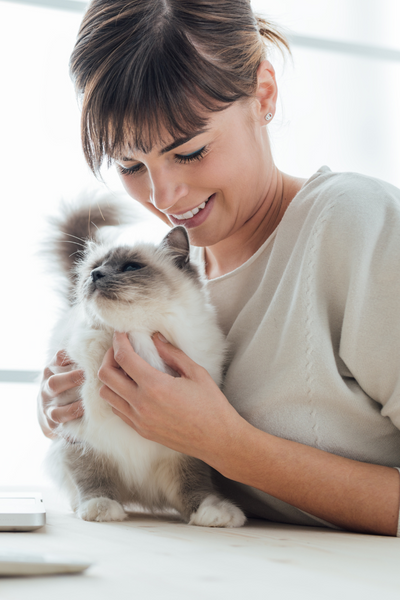
Signs of a Happy Pet
As experienced pet owners know, animals have many ways of expressing themselves to us, but there are signs of happy pets that even experienced owners may not have noticed. Both cats and dogs are even more expressive than many people know, but by the end of this guide we’ll be better able to connect with our furry friends.
7 Signs of of a Happy Cat
First, we’ll take a closer look at cats, and how they communicate their thoughts and feelings to their humans. While each has their own personality, and some may choose some ways to express themselves over others, but they will all do these things at one time or another.
1. Meowing - While most cat owners know that cats rubbing against you and purring are very common displays of affection, few also know that the simple act of meowing at their human shows your cat cares for you. Cats only meow when trying to communicate with us, so pay attention when they do.
2. Grooming - Cats will often come to where their favorite humans spend their time and groom themselves there. A happy cat will groom themselves regularly, and usually around you, so you’ll want to check up on them if this behavior changes, and help them take care of themselves.
3. Playing - A cat that’s happy and fulfilled will often go to their favorite people for attention and play, as well as interacting with other pets in the area. Sad, scared, or depressed cats will often hide or avoid all contact with others until whatever’s causing the stress is resolved.
4. Proximity - Happy cats usually enjoy spending their time close to their owners. You’ll find content cats sleeping on and around you, laying on your lap, and just generally being nearby. They tend to spend most of their time where they feel the safest, and with those that make them happiest. If your cat seems to be hiding itself away more often than not, something may be bothering them.
5. Slow Blinking - Another common sign of a happy cat that isn’t always understood by their humans is slow blinking. This is when a cat looks you in the eye and slowly blinks. To them, this is similar to how we would blow a kiss to a loved one, and they are happy to have the expression returned in kind.
6. Rolling Over - Like dogs are known to do, many cats will roll over and expose their stomach to their human as a sign of trust. Be careful, though, not all cats enjoy having their belly scratched. Misunderstanding this gesture is a quick way to get scratched, but if you know your pet well enough you’ll know whether or not it’s safe to pet them when they flop over like this.
7. Love Bites - As with the previous sign, love bites can be easily misunderstood, but they are in fact a form of affection for cats. These bites are usually lighter than normal, aggressive behavior, and are often accompanied by other forms of affection, such as snuggling or purring during or after “love biting” you.
7 Signs of a Happy Dog
Now, let’s study dogs’ forms of expression, and see what we can learn. In general, dogs are easier to read than cats, but they do have a range of expression that is often overlooked. Though simpler and easier to understand, dogs are complex creatures in their own right.
1. Excitement - Most happy dogs will get a burst of excitement when their favorite person returns home. How this is displayed differs from dog to dog, but common forms of expression are “taps”, quick light steps back and forth; “hops”, the little jumps into the air with seemingly no direction; or “wiggles”, the intense shaking of one’s tail, or in cases of extreme excitement, the whole body.
2. Sleeping - Dogs generally sleep more than we do, a happy dog can sleep as much as sixteen hours a day. If your dog sleeps often, and deeply, then they’re likely doing well. Upset, hurt, or sick dogs often will be restless, and will have trouble falling or staying asleep.
3. Proximity - Just like cats, dogs will want to be around as much as possible when they’re happy and feeling well. If your dog seems to be shying away from you, or not standing near you, then they may be stressed or not feeling well. Most dogs’ favorite form of praise also involves pets, so be aware if the dog suddenly doesn’t want the attention it usually does.
4. Respect - Happy dogs are good dogs, they want to please us because people being happy makes them feel good. If your dog seems to be more destructive than others of its breed or age, then it may be acting out for one reason or another. If this occurs it's best to check for anxiety or stress, and eliminate the cause of these negative feelings, if possible. Boredom can be another cause of misbehavior, though, so make sure your pets are exercised well in order to keep them well-behaved.
5. Sharing - Dogs love to share their happiness with their owners, and this is expressed in many different ways. The most common way is through bringing you their favorite toys, either to play with or mend, as needed. When they’re happy and trusting, they want to share everything with you, so you’ll also find them eating in the same room, or at the same time as you, and trying to copy you at times.
6. Empathy - When dogs are content, they like to have jobs. For most of our furry friends, that job is keeping our spirits up, and bringing light into the lives of those around them. As we see many service dogs do for those that have suffered trauma, most dogs will sense sadness or distress in those close to them, and do their best to relieve their people of these stressors. Happy dogs want everyone else to be happy, and will go out of their way to make that happen, if they can.
7. Rolling Over - Like with cats, dogs will commonly roll over and expose their stomach to humans to show trust and affection. Unlike those finicky felines though, almost all dogs love to get belly scratches, more so than most other forms of affection, so don’t be afraid to reward those good dogs with pets.
Happy Pets are Good Pets
New pet owners will often find themselves wondering if their pet is just “bad”, or untrainable, but this usually stems from misunderstandings. By learning how to tell when we’ve made our pets happy, and when they’re struggling, we can more easily make their home the comfortable and safe environment that it should be for them, and us.
If your pets don’t do some of the things mentioned here, don’t worry. Not all pets act the same, and some are more prone to other shows of affection and happiness than they are others. The most important thing is caring, and being aware of your pets’ actions, and the reasoning behind them. The better we understand them, the better we can communicate and live well with our pets.

Post a Comment!